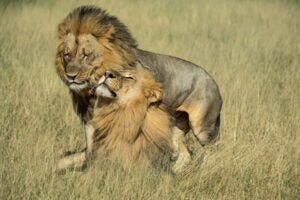
CAPE TOWN, South Africa—South African citizens have spoken out against the cruel practice of hunting wild animals for trophies. A new 2022 IPSOS survey, commissioned by animal protection charity Humane Society International/Africa, reveals that 68% of the South African population oppose trophy hunting, and the majority (65%) oppose the practice of canned lion hunting. The poll also demonstrates the public’s opposition to the trophy hunting of specific species, including the hunting and export of trophies of black rhinos, elephants and leopards for which the 2022 hunting and export quotas were released earlier this year.
South Africa is Africa’s largest exporter, and the second largest exporter globally (behind Canada), of mammal species listed under the Convention on International Trade in Endangered Species of Wild Fauna and Flora.
Dr Matthew Schurch, wildlife specialist for HSI/Africa, said: “This new survey shows without a doubt that most South Africans reject the unjustifiable practice of trophy hunting, including canned lion hunting—and opposition to trophy hunting continues to grow. The South African government is out of step with public opinion because it allows people to hunt wild animals for the purpose of collecting their remains to adorn their homes. Trophy hunting does not significantly contribute to conservation. In South Africa one-third of hunting trophies of CITES-listed mammals are from captive bred animals, and most are non-native or species not subject to science-based population management. This senseless killing of wild animals is not only unethical and cruel, but a disgrace to brand South Africa.”
This significant IPSOS survey reports only on local data sourced from a diverse South African demographic across all provinces. The key findings from the IPSOS survey include:
- 68% of South Africans fully oppose or oppose to some extent the practice of trophy hunting—an increase from 56% in a similar 2018 survey.
- 65% of South Africans fully oppose or oppose to some extent the practice of canned lion hunting—an increase from 60% in a similar 2018 survey in 2018.
- 64% of South Africans disagree with the trophy hunting of elephants, rhinos, and leopards.
- 63% of South Africans disagree with the trophy hunting of lions.
- 66% of South Africans disagree with the trophy hunting of hippos.
- 60% of South Africans disagree with the trophy hunting of giraffes.
- Regarding the 2022 hunting and export quotas announced by the Department of Forestry, Fisheries and the Environment (DFFE) in February 2022, 63% oppose the quota for 150 elephants, 62% oppose the quota for 10 black rhino, and 61% oppose the quota for 10 leopard.
HSI/Africa released the survey report leading up to Part B of its litigation against the DFFE, challenging the 2022 hunting and export quotas of 10 leopards, 10 black rhinos and 150 elephants. In April 2022, the High Court of the Western Cape handed down judgment in the application for an interim interdict against the DFFE’s 2022 hunting and export quotas for leopard, black rhino and elephant. The judgment confirmed that, on the face of it, the 2022 trophy hunting quotas, as issued by the DFFE’s Minister Barbara Creecy, may be invalid and unlawful. That will be determined in Part B of the proceedings, now in process.
A previous study detailing South Africa’s role in the international trade in hunting trophies of mammal species listed under CITES during 2014-2018 (the most recent five-year period for which data is available) demonstrated that about 83% of CITES-listed mammal trophies exported from South Africa are captive-bred animals or non-native species, and native species with no national conservation management plan nor adequate data on their wild populations or how those populations are impacted by of trophy hunting. This data directly undermines the claim that trophy hunting promotes conservation.
Trophy hunting by the numbers in South Africa:
- South Africa is the second largest exporter of hunting trophies of CITES-listed mammal species globally, exporting 16% of the global total of hunting trophies—4,204 on average per year.
- South Africa is the biggest exporter of CITES-listed mammal species in Africa. South Africa exported 50% more trophies than Africa’s second largest exporter, Namibia, and more than three times that of Africa’s third largest exporter, Zimbabwe.
- Between 2014 and 2018, South Africa exported:
- 574 African leopard trophies, or 115 per year on average. 98% of African leopard trophies exported from South Africa were wild-sourced, while 2% were bred in captivity.
- 1,337 African elephant trophies, or 268 per year on average, virtually all wild-sourced. 47% of the total were exported to the United States.
- 21 black rhino trophies, or five per year on average, all wild-sourced.
- 68% of CITES-listed mammal trophies exported from South Africa were from wild-sourced animals, while 32% were from captive animals—19% bred in captivity and 13% were born in captivity.
Population and Conservation Status of IPSOS species surveyed:
According to the IUCN Red List of Threatened Species (date of last assessment indicated):
- The African savanna elephant is globally assessed as endangered, with a decreasing population trend (2020).
- The black rhino is globally assessed as critically endangered, with an increasing population trend and number of mature individuals at 3,142 (2020).
- The leopard is globally assessed as vulnerable, with a decreasing population trend (2015).
- The African lion is globally assessed as vulnerable, with a decreasing population trend, with an estimated number of mature individuals between 23,000 – 39,000 (2014)
- The hippopotamus is globally assessed as vulnerable, with a stable population trend and 115,000-130,000 at the last assessment (2016).
- The giraffe is globally assessed as vulnerable, with a decreasing population trend and 68,293 mature individuals (2016)
Download the IPSOS Survey Report.
ENDS
Media contact: Leozette Roode, HSI/Africa media and communications specialist: +27 (0)71 360 1104; LRoode@hsi.org
